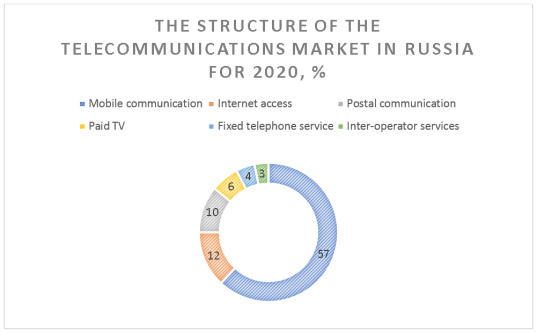The article examines the impact of the pandemic and the prospects for development on the sphere of the modern telecommunications market.
Keywords: telecom, telecommunications, telecommunications market, direction of development.
The Russian telecommunications market is a large and dynamically developing industry formed by three leading operators. Due to the small number of sellers and the monotonous type of services they offer, the market is characterized by a monopolistic structure. This means that the actions of each of the agents have a significant impact on the equilibrium indicators of the market in general through variations in supply volumes.
The telecommunications market occupies a special place in the modern market economy, since in the second half of the XX century information became an integral element of production, and there was a need to create social institutions that ensure the creation, accumulation, processing and transmission of information». The possession and use of reliable and timely information provides its holders with economic, social and political advantages and benefits. The transition from a centralized economy to a market economy in our country has led to an intensive growth of the telecommunications market. Modern Russian companies have an ever-increasing demand for information and communication services. To date, since there are dis-proportions between supply and demand in various service sectors, the telecommunications market is not sufficiently developed, although the number of firms developing this sphere is increasing. There is an interest in the Russian market from the largest foreign telecommunications companies. It is obvious that the telecommunications market has great prospects of development in our country [1–2].
The level of development of telecommunication systems is one of the fundamental conditions that give great opportunities for the development of modern business, which has long crossed national borders. Today, the globalization and integration of telecommunications companies can be attributed to the leading trends in changes in the structure of this market around the world [3–4].
During the COVID-19 pandemic, the telecommunications sector, like most other sectors of the economy, was negatively affected by its consequences in all foreign countries. Citizens and organizations had to rely on telecom operators, as most of the employees were transferred to remote work, students — to distance learning, and the sale of goods on the Internet increased exponentially [5].
According to experts, the following main global trends in the development of the telecom industry are observed today:
- bringing telecom closer to content: videos and games;
- shifting growth in related directions: information security, data center and IoT;
- work with new industries for telecom: fintech, smart home, digital medicine and education;
- development of new directions around the needs of the client: home, mobility, security, work, communication.
The COVID-19 pandemic and the prospects of repeated outbreaks of viral infections in the future form a public demand for a change in the existing way of life, the prevailing social and economic processes, and approaches to doing business.
At the heart of these changes is the need for a rapid and massive transition of people to communicate online and offline remote work. Such changes can contribute to strengthening the role of digital and IT sector companies in the economy, will give impetus to the development of technologies and communication networks, data processing and storage infrastructure, which are able to absorb the avalanche-like growth in traffic consumption, ensure sufficient network bandwidth, network connectivity stability, and most importantly — provide a wide range of demand-digital services to the population, business and the state.
According to the reports of the world's leading telecommunications companies, the negative financial effect directly related to the COVID-19 panda, on average, amounted to 4–8 % of revenue. The most affected segment of the operators' business was the roaming business due to a reduction in the number of trips by customers. At the same time, forced remote work, combined with increased demand for home entertainment in conditions of self-isolation, led to a steady increase in data traffic, mainly via fiber, as well as mobile communications [6].
In the structure of the Russian telecommunications market, the largest share of about 57 % is occupied by mobile communication services [7], according to the Ministry of Finance of Russia (Figure 1).

Fig. 1. Structure of the telecommunications market in Russia
References:
- Lokotkov Anatoly Alekseevich Telecommunications market: current state and development prospects // Socio-economic phenomena and processes. 2011. No.1–2. URL: https://cyberleninka.ru/article/n/rynok-telekommunikatsiy-sovremennoe-sostoyanie-i-perspektivy-razvitiya (accessed: 05/31/2022).
- Merkulova Svetlana Aleksandrovna Features of the development of the telecommunications services market in the CIS region // Bulletin of the RUDN. Family: Economics. 2010. No.3. URL: https://cyberleninka.ru/article/n/osobennosti-razvitiya-rynka-telekommunikatsionnyh-uslug-v-regione-sng (date of address: 31.05.2022).
- Nanushyan Shushik Spiridonovna The place and role of telecommunications companies of the Russian Federation in the world economy // Bulletin of GUU. 2015. No. 12. URL: https://cyberleninka.ru/article/n/mesto-i-rol-telekommunikatsionnyh-kompaniy-rf-v-mirovoy-ekonomike (accessed: 05/31/2022).
- Sinitsa Sergey Aleksandrovich Trends in the development of the market of telecommunication services // VEPS. 2018. No.2. URL: https://cyberleninka.ru/article/n/tendentsii-razvitiya-rynka-telekommunikatsionnyh-uslug (accessed: 31.05.2022).
- Ma Min FEATURES OF THE DEVELOPMENT OF THE MODERN TELECOMMUNICATIONS MARKET // Greater Eurasia: development, security, cooperation. 2020. No.3–2. URL: https://cyberleninka.ru/article/n/osobennosti-razvitiya-sovremennogo-telekommunikatsionnogo-rynka (accessed: 05/31/2022).
- Proskura D. V., Proskura N. V. Social orientation of communication services // Vestnik NGIEI.-2013.-№ 7(26).- Pp.102–111.
- Van A. L., Tretyakov M. M. The current state of the market of tele-communication services in the Russian Federation (on the example of the segment cellular communications) // electronic scientific publication «Scientific notes of TOGU». — 2015. — Vol. 6. -No. 4. — pp. 154–157.







